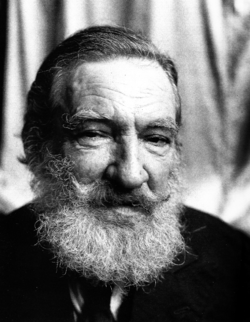Armando Reverón
| Armando Reverón | |
|---|---|
 | |
| Born |
Armando Julio Reverón May 10, 1889 Caracas, Venezuela |
| Died |
September 18, 1954 (aged 65) Caracas, Venezuela |
| Nationality | Venezuelan |
| Known for | Painting, drawing, sculpture |
Armandro Reverón (1889–1954) Armando Reverón was a painter and sculptor in Venezuela of the late 19th and early 20th centuries, and arguably the most influential exponent of Venezuelan impressionism. While his mental health deteriorated throughout his life, his artistic abilities remained. His house by the northern coast of Venezuela housed the Reveron Museum, although it was severely damaged by the Vargas mudslides in December 1999. He is the subject of various homages in different medias, and is remembered by his "muñecas" or dolls.
Biography
He began his studies at the Colegio de los Padres Salesianos in Caracas. His maternal great-uncle, Ricardo Montilla, who had studied in New York, teaches to him natural drawing and awakens his artistic vocation, from child showing interest in painting. In 1896 he was transferred to Valencia after the failure of his parents' marriage. Armando is sent home from Rodríguez-Zocca's family, who took care of his early education.
Under the care of Rodríguez-Zocca's family, Reverón established a close relationship with Josefina, the daughter of the couple, and came to appreciate her like his own sister. The walls of the house were some of the first paintings of Reverón, where he attempted to portray the family maid, Juanita Carrizales. Rodríguez-Zocca's family told him to Dolores on temperament of Reverón is "sad, angry and melancholy". Between 12 and 13 years, suffering from typhus, which for many shall affect belief psychically for the rest of his life.
Artistic changes
Reverón built several ranches in the terrain that he bought in Macuto, the principal ranch was his workshop and the walls were tables and the thatched roof. Around his waist he was placed a large bag that save driftwood that worked like brush.
The decision to move also coincided with a change of behavior and of course, a transformation of his artistic concepts. In this period, by adopting primitive habits and detached from the city, Reverón could develop a deeper understanding of the nature and this led him to employ a method of painting, and to adopt procedures and materials that suited his desire to represent the atmosphere of the landscape under dazzling effects produced by direct sunlight also created color values and devised new media, using native elements.
Thus entered what the critic Alfredo Boulton called his Período Blanco, located roughly between 1924 and 1932. In 1933, he won a first award to be an exhibition of his work at the Ateneo de Caracas, which was then presented in the gallery Katia Granoff in Paris, France.
In early 1940, he began his Período Sepia, which corresponds to a set of painted canvas on the coast and in the port of La Guaira and brown tones where mop holder are the dominant color value of the composition; landscapes land and sea where marine highlights from the beach, which was followed by a period of depression after suffering a psychotic breakdown which forced confinement in "San Jorge" sanatorium from "José María Finol". Once recovered not repainted as before.
From that moment, he took refuge in a magical universe, around objects and dolls created by him, gave birth to the last and delirious expressionist stage of his work figurative period characterized by the use of materials such as chalk, crayons and a theatrical fantasy that became more and more uncontrollable but, through a drawing that aspired to academic correctness, sought to restore the emotional balance of Reverón.
Further reading
- Elderfield, John; Luis Perez-Oramas; Glenn Lowry (2001-03-01). Armando Reveron. The Museum of Modern Art. ISBN 0-87070-711-6.
External links
- 2007 Reverón exhibition at the MOMA
- Noelia Sastre, "Reverón encandila a Nueva York" Newspaper El Universal
|